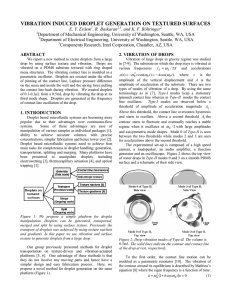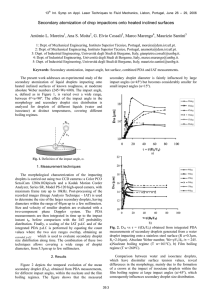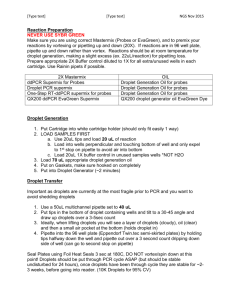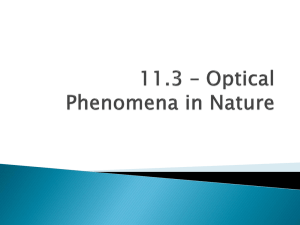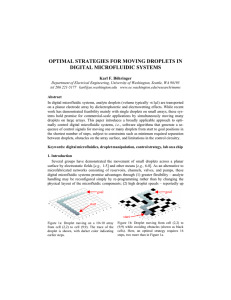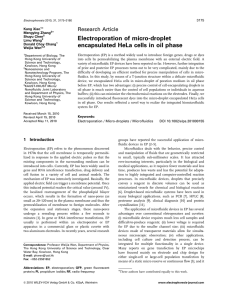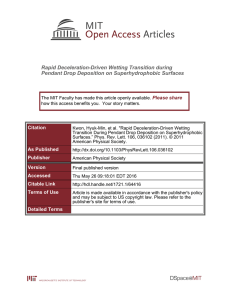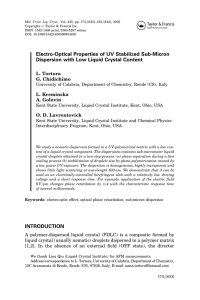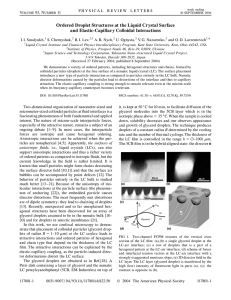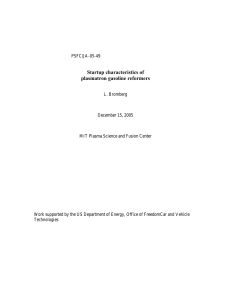VIBRATON INDUCED DROPLET GENERATION ON TEXTURED SURFACES E.Y. Erdem , R. Baskaran
advertisement
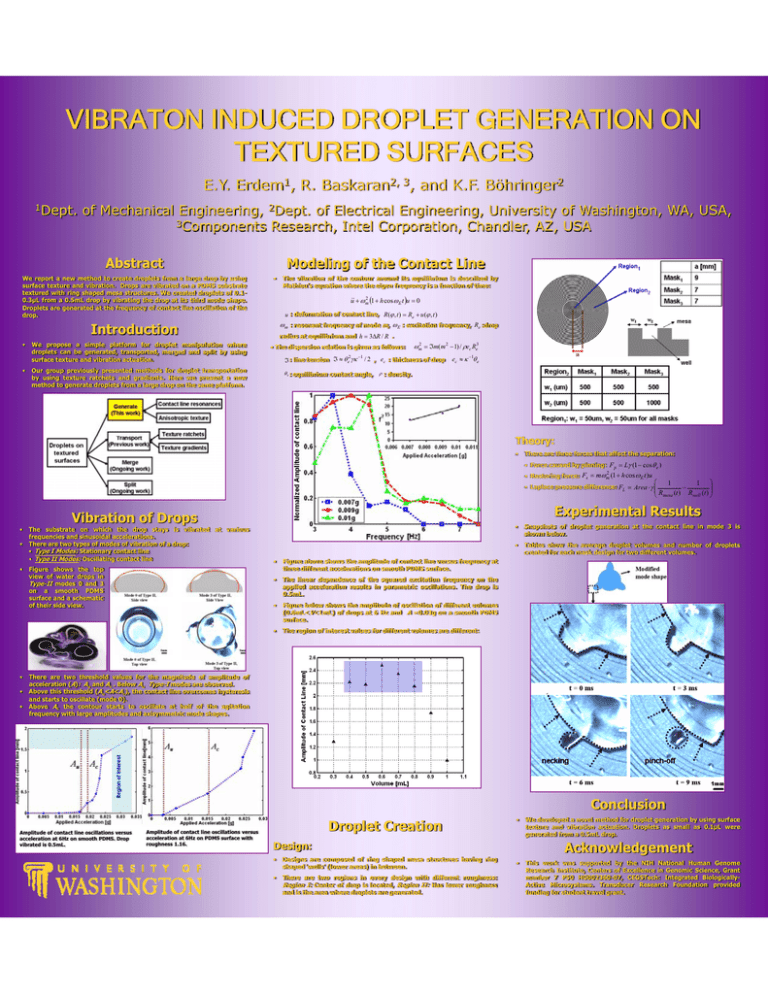
VIBRATON INDUCED DROPLET GENERATION ON TEXTURED SURFACES E.Y. Erdem1, R. Baskaran2, 3, and K.F. Böhringer2 1Dept. of Mechanical Engineering, 2Dept. of Electrical Engineering, University of Washington, WA, USA, 3Components Research, Intel Corporation, Chandler, AZ, USA Abstract We report a new method to create droplets from a large drop by using surface texture and vibration. Drops are vibrated on a PDMS substrate textured with ring shaped mesa structures. We created droplets of 0.10.3μL from a 0.5mL drop by vibrating the drop at its third mode shape. Droplets are generated at the frequency of contact line oscillation of the drop. Modeling of the Contact Line • u&& + ω m2 (1 + h cos ω E t )u = 0 u : deformation of contact line, R(ϕ , t ) = Re + u (ϕ , t ) ω m : resonant frequency of mode m, ω E : excitation frequency, Re :drop Introduction • • We propose a simple platform for droplet manipulation where droplets can be generated, transported, merged and split by using surface texture and vibration actuation. The vibration of the contour around its equilibrium is described by Mathieu’s equation where the eigen frequency is a function of time: radius at equilibrium and h = 3ΔR / R . • The dispersion relation is given as follows: ℑ : line tension Our group previously presented methods for droplet transportation by using texture ratchets and gradients. Here we present a new method to generate droplets from a large drop on the same platform. ℑ ≈ θ e2γκ −1 ωm2 = ℑm(m 2 − 1) / ρec Re3 / 2 , ec : thickness of drop θ e : equilibrium contact angle, ec ≈ κ −1θ e ρ : density. Theory: • There are three forces that affect the separation: • Force caused by pinning: F p = Lγ (1 − cosθ e ) • Restoring force: Fs = mω m (1 + h cos ω E t )u 2 ⎛ • Laplace pressure difference: FL = Area ⋅ γ ⎜ ⎜ 1 ⎝ Rmesa (t ) • • • • • • Figure shows the top view of water drops in Type-II modes 0 and 3 on a smooth PDMS surface and a schematic of their side view. 1 ⎞ ⎟ Rwell (t ) ⎟⎠ Experimental Results Vibration of Drops The substrate on which the drop stays is vibrated at various frequencies and sinusoidal accelerations. There are two types of modes of vibration of a drop: • Type I Modes: Stationary contact line • Type II Modes: d Oscillating ill i contact line li − • Figure above shows the amplitude of contact line versus frequency at three different accelerations on smooth PDMS surface. • The linear dependence of the squared excitation frequency on the applied acceleration results in parametric oscillations. The drop is 0.5mL. • Figure below shows the amplitude of oscillation of different volumes (0.6mL<V<1mL) of drops at 6 Hz and A =0.03g on a smooth PDMS surface. • The region of interest values for different volumes are different: • Snapshots of droplet generation at the contact line in mode 3 is shown below. • Tables show the average droplet volumes and number of droplets created for each mask design for two different volumes. • We developed a novel method for droplet generation by using surface texture and vibration actuation. Droplets as small as 0.1μL were generated from a 0.5mL drop. • This work was supported by the NIH National Human Genome Research Institute, Centers of Excellence in Genomic Science, Grant number 7 P50 HG002360-07, CEGSTech: Integrated BiologicallyActive Microsystems. Transducer Research Foundation provided funding for student travel grant. There are two threshold values for the magnitude of amplitude of acceleration (A): Au and Ac . Below Au Type-I modes are observed. Above this threshold (Au<A<Ac), the contact line overcomes hysteresis and starts to oscillate (mode 0). Above Ac the contour starts to oscillate at half of the agitation frequency with large amplitudes and axisymmetric mode shapes. Conclusion Amplitude of contact line oscillations versus acceleration at 6Hz on smooth PDMS. Drop vibrated is 0.5mL. Amplitude of contact line oscillations versus acceleration at 6Hz on PDMS surface with roughness 1.16. Droplet Creation Acknowledgement Design: • Designs are composed of ring shaped mesa structures having ring shaped ‘wells’ (lower areas) in between. • There are two regions in every design with different roughness: Region I: Center of drop is located, Region II: Has lower roughness and is the area where droplets are generated.
